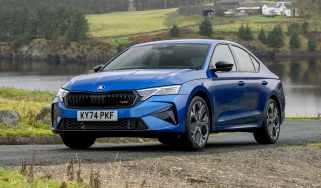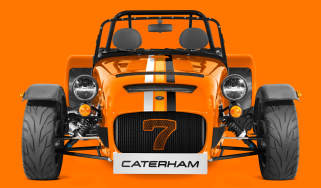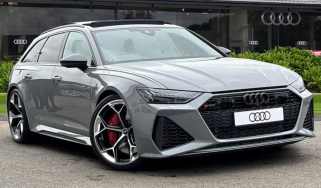Audi RS6 (C6, 2008 - 2010): a V10 family car with supercar power
The C6-generation Audi RS6 is a V10-powered sleeper with supercar pace and in 2024, a bargain price
‘This thing is conversation-stopping, passenger-nausea-inducing fast. Everywhere.’ That’s how Harry Metcalfe described the C6 RS6 he ran for a year on evo’s Fast Fleet back in 2008. Even in a world of hybrid supersaloons and 1000bhp-plus electric cars, that description holds true today.
Some believe it took until the (admittedly excellent) C7 generation for the RS6 to really get into its stride, but for the maddest, most eccentric version of all, the C6 takes the cake. Its nuclear-grade twin-turbo V10 generates 572bhp – more than the 911 GT2 of the time and not a million miles away from the current RS6 Performance. That gives it a 0-62mph time of 4.5sec, and with impenetrable four-wheel-drive traction and a slick-shifting six-speed automatic gearbox, you get the sense the RS6 can achieve that anywhere, without breaking a sweat. Predictably, it drinks fuel just as quickly – we averaged around 18mpg during our time with one.
> BMW M5 Touring (E61, 2007 - 2010): review, specs and buying guide
The C6 came at a time when Audi RS products didn’t shout about their performance from the outside. The Quattro-style box arches almost give the game away, but the uninitiated could easily mistake it for a generously specced A6 Avant rather than a Porsche-eating mega-estate. This subtlety is a big part of the appeal, so too is the vast, beautifully built cabin that can carry four adults – and their luggage – in comfort over long distances.
More reviews
The C6 doesn’t shed kilos and come alive in your hands like the best modern fast estates, but even some pure-bred sports cars will have trouble keeping up with one. It might weigh 1985kg, but dial up to the Dynamic setting for the adaptive dampers and the RS6 steamrolls along with sure-footed composure and huge pace, with a shade of understeer to work against and keep your commitment in check. It’s not a natural thriller, but it is a crushingly effective car all the same.
What to pay
The C6 is also something of a bargain on the used market today, running costs notwithstanding. Around £14,000 is the entry point for examples on over 100,000 miles, while £22,000 could bring that as low as 50,000 miles. It’s always worth making sure that any potential purchase is mechanically fit with a solid maintenance history, because the RS6 can throw up some big bills.
What to look out for
Oil pump seals have been known to fail with age, causing fluid to leak onto the undertray – not always easy to spot. The seal itself costs a few pence, but replacing it is usually an engine-out job that can top £3000. Coolant pipes behind the front wheelarch liner have been known to corrode, too, potentially resulting in failure and water loss. Catch it early to avoid catastrophic engine damage, but budget for an engine removal to replace the pipes (or do the job alongside the oil seal replacement). Some garages have been known to carry out the work with the engine in situ, however, which is much cheaper at around £1000. Better news is that Audi’s diagonally opposed hydraulic Dynamic Ride Control damping system has proven to be more robust in the C6 than in the C5, which suffered common failures and expensive repairs.
What we said
'That a car with 572bhp, an all-wheel-drive system split 40:60 front-to-rear and gargantuan 275/35 ZR20 Pirelli P Zeros is fast across the ground isn’t exactly a great shock. But that a car weighing over two tons can carry so much speed with such composure, without the suspension ever crashing into its bumpstops, is borderline remarkable. Perhaps more remarkable still is that I’m driving a car capable of so much and yet so far I’m almost completely unmoved: no goosebumps, no childish whooping (embarrassingly I do tend to do this when driving something really special). I’m impressed, maybe even awestruck when I can touch the violence of the V10’s top-end power, but I’m not really excited.
Fire the V10 with a prod of the starter button just to the left of the gear selector and the RS6 does a credible impression of a supercar. The V10 is quieter than the one you’ll find in a Gallardo but it sounds busy, bassy and exotic. Just hearing it clear its throat goes some way to justifying the RS6’s £77,625 asking price (£10K more than the BMW M5 Touring and £3000 more than a Cayenne Turbo). Slip it into ‘D’ and you’re gently away on a wave of torque, though not without a delicate right foot. There is plenty of torque, of course, but the throttle pedal is very sensitive. The merest flick of the right foot sees the V10 snap into life like you’re trying to extract a 0-60mph time. As in the new TT, the mapping for the drive-by-wire throttle seems to give a 100 per cent opening even if you only ask for 30 per cent.
Until you’ve learned to finesse your right foot, the oversensitive throttle can make the RS6 feel a little clumsy, but in fact its V10 is a beautifully progressive device. It pulls hard from tickover, the power ramping up through 2500-3500rpm, soaring at 4500-5000 and then – scarcely believably – building still further to a dizzying climax as it closes in on the 6750rpm limiter. It’s tricky comparing an upright, conventional car with a proper mid-engined supercar, but I doubt a Ferrari F430 could cope with the scale and breadth of the RS6’s performance without a very talented driver in the hot seat. Good job Audi fitted 390mm discs and six-piston callipers up front; they have phenomenal power and fine progression.
Even in Dynamic mode, the suspension still feels a shade too soft at this sort of pace. On downhill sections where you’re braking into a corner, the car pitching on the way in, you notice it struggling to contain the sudden lateral loading as you turn hard. Roll builds quickly and with it understeer. To be fair it never scrubs wide, but there’s just a few degrees of slip that stays constant as the corner opens out and you start to unleash the engine. In Sport the body control is much tighter but it brings with it an element of bounce over particularly ragged surfaces. It feels like the ideal damper setting is in there somewhere, but it just hasn’t been assigned a name yet…
Of course, much of this is irrelevant for the sort of people who own RS6s. They tend to have a 911 or two in the garage, maybe a vintage Ferrari nestled alongside them. The RS6 is their daily runabout and they buy it because it’s an estate car with 572bhp and because they have a sense of humour. And because it’s a brilliant everyday car that just happens to have more stonk than their Porsche or Ferrari. A sledghammer to crack a nut it may be, but the RS6 is still a wickedly desirable thing if you have a scalpel waiting in the garage for when you really want to have fun.' – Jethro Bovingdon
I bought one
A car mechanic since he was 17, Martin Adams of fast Audi specialists Unit 20 began specialising in the S and RS models six years ago, having fallen for the brand after owning a twin-turbo V6-engined S4. ‘I followed that up with a 2003 RS6 Avant that I owned for four years,’ says Martin, ‘during which time I did every modification known to man, then invented a few of my own. Eventually, though, I felt I needed to change up and move with the times, so in 2010 I bought a brand new, Suzuka Grey, V10-engined RS6 saloon.'
‘It’s a totally different car to the V8 I had before. The interior is beautiful, the switchable suspension works really well, and the gearbox is silky smooth – I just can’t fault anything about the car. And to say that it’s a super-fast cruiser is a serious understatement. Although it’s a big, two-ton car, I have used it extremely hard on the track, where it was not only bullying modified RS4s out of the way, but its brakes were fade-free, unlike the old model’s…'
‘After a few modifications the power of my car is now up to 720bhp; later on I’m going to carry out the big turbo conversion to take it to 850bhp. I don’t foresee the power increase causing any problems, as in a V10 it doesn’t represent a large load per cylinder.'
Audi RS6 (C6) specs
| Engine | V10, 4991cc, twin-turbo |
| Power | 572bhp @ 6250-6700rpm |
| Torque | 479lb ft @ 1500-6250rpm |
| Weight | 1985kg |
| Power-to-weight | 293bhp/ton |
| 0-62mph | 4.5sec |
| Top speed | 155mph |
| Price new | £77,625 (2008-10) |
| Value today | From £14,000 |



